Part of a series of articles titled The Waterford, Virginia National Historic District.
Article
It Takes a (Waterford) Village: Expanding the Bounds of National Historic Landmarks
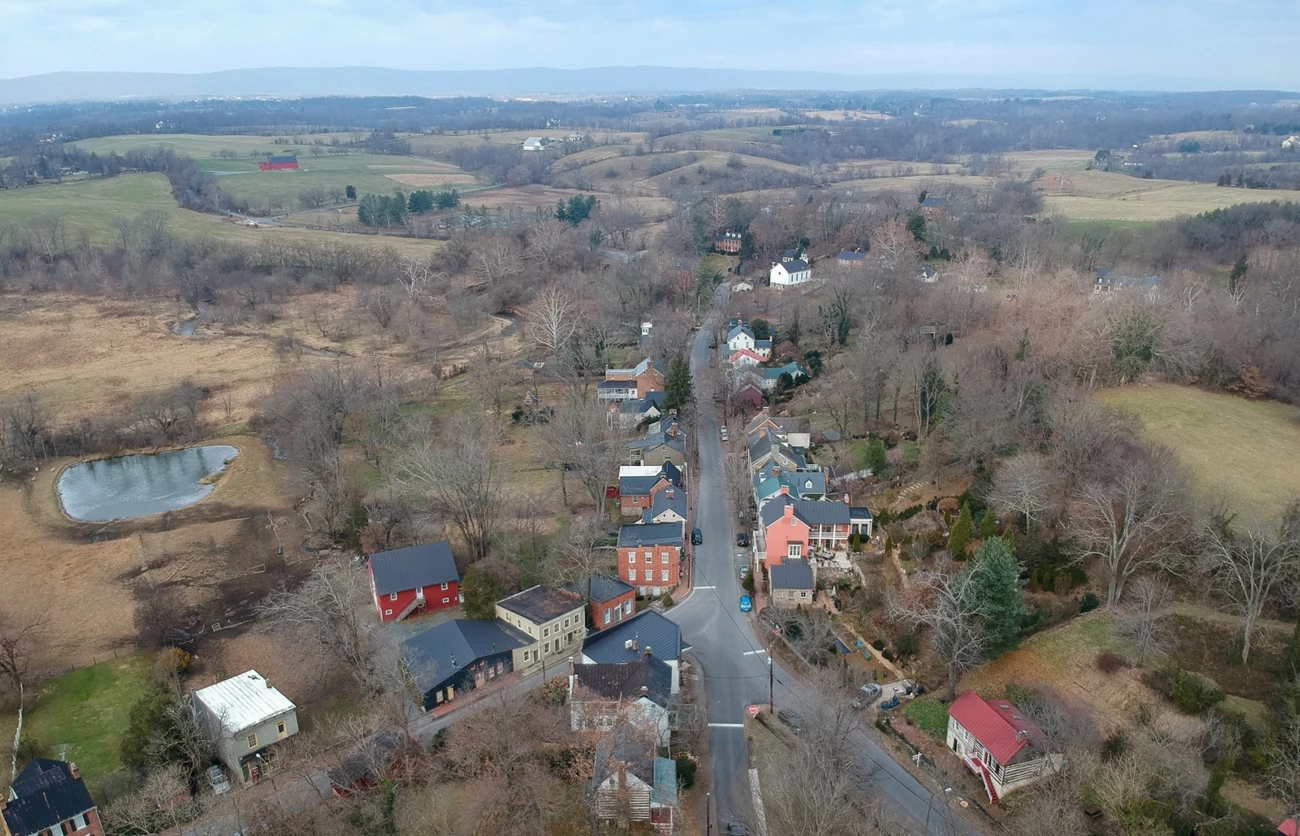
NPS Photo/University of Delaware, Center for Historic Architecture and Design staff, December 2019
Documenting Important Conservation Strategies Through Oral Histories
The Waterford Historic District, located in the Catoctin Valley in Loudoun County, Virginia, is among the best-preserved examples of the many agricultural villages that emerged in the United States after the American Revolution. This historic village retains important reminders of how our nation evolved during the market revolution, which transformed the nation in the half century following the American Revolution. Additionally, the intensive preservation campaign to save Waterford’s rural village landscape during the twentieth century illustrates significant national developments in historic preservation.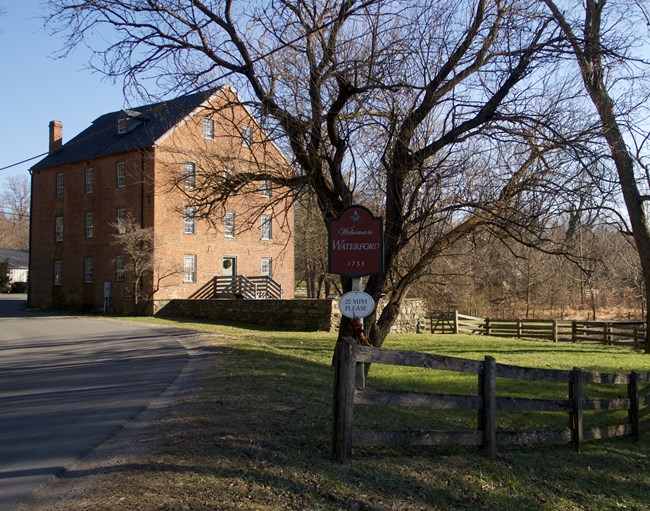
NPS Photo/University of Delaware, Center for Historic Architecture and Design staff, December 2019
The addition of the Waterford Historic District to the National Register of Historic Places in 1969, and its subsequent designation as a National Historic Landmark in 1970, represented a turning point in the preservation story. The inclusive, expansive boundaries drawn for the historic district at that time were innovative and ambitious—including a total of 1,420 acres that encompassed the pastoral views of farmlands, forests, and hills that surround the village. To retain the appearance and feel of a nineteenth-century farming village, that rural open space needed to be conserved as much as individual buildings in the village core—a major challenge, especially in the face of increasing development pressures during the late-twentieth century, as Washington D.C.’s commuter orbit rapidly expanded.
Easements
A key theme that emerged during the interviews was the critical role of preservation easements in protecting Waterford from incompatible development. Preservation easements are voluntary legal agreements, typically documented in the form of a deed, which permanently protects a significant historic property or open space. Multiple informants identified Waterford’s easement campaigns, both building easements and open space/land conservation easements, as the most important tool for achieving the district’s high level of preservation. Informants highlighted the sheer volume and density of easements within the National Historic Landmark district as particularly remarkable and effective. Milton Herd, a former lead planner for Loudoun County, suggested that easements, as a technical tool, were “probably the most powerful because they’re just so strong” and “permanent in nature.”
Well, again, the most effective isn’t a tool. It’s the whole effort. It’s the promotion and an education led by the Waterford Foundation, supported by the county government. But as a technical tool, I think the easements are probably the most powerful because they’re just so strong. They do require constant maintenance, though, and so that’s one of the things that this whole effort with Waterford has to do is keep going. It can’t coast on its own.
-Milton Herd, 2021
Calder Loth, an architectural historian and former easement coordinator in Virginia, believes that Waterford has “probably the largest number of easements on a very concentrated area” in the state of Virginia, if not nationally, and that the extent of Waterford’s easement protection has created a critical mass that ensures a certain baseline level of preservation for Waterford.

W. Brown Morton III, who was a Waterford resident for many years and a professor of historic preservation, recalls his personal goal to establish easements on every parcel within Waterford’s National Historic Landmark district, using a map on which he colored in the parcels as they were protected. While not 100 percent successful in that goal, he and other informants discuss the “unusual” community efforts to achieve such a high level of coverage through easements."I must say that it is probably the largest number of easements on a very concentrated area, certainly in the state. I don't know how it figures nationally, but I would say it's right up there. I'm not aware of any kind of similar program like that, that involves so many properties, so many property owners on relatively small village or area."
-Calder Loth, 2021

“I remember adopting as a personal goal for myself. I made a map of the historic district and all of its boundaries. And then one by one by one, I filled in where there were easements. And my goal was to get the whole boundary eased. I did not succeed in that, but we got quite well into it in that some neighbors were anxious to help, and others were less anxious to help.”
-W. Brown Morton III, 2021
John Chamberlin, whose grandfather was one of the first to restore historic houses in Waterford during the 1930s, remembers that the Waterford Foundation successfully encouraged many “regular homeowners” to join the easement campaign, to the point where “peer pressure” from neighbors led to increased participation.

“ In terms of the preservation of buildings and open spaces, there were two major things. One was, we started the program of placing easements, facade easements, on all of the structures that the Foundation owned and encouraged people, just regular homeowners, to do the same. And quite a number did. I know, at that time, my parents owned two or three houses right there on the main street and they protected those, and other people did as well. So that—there was some resistance to it because I think people thought it might, in the long term, affect the value of their property. But I think it was fairly successful in getting a lot of people to do it and that kind of thing is some peer pressure, you know, to do the same thing your neighbors were doing.”
-John Chamberlin, 2021
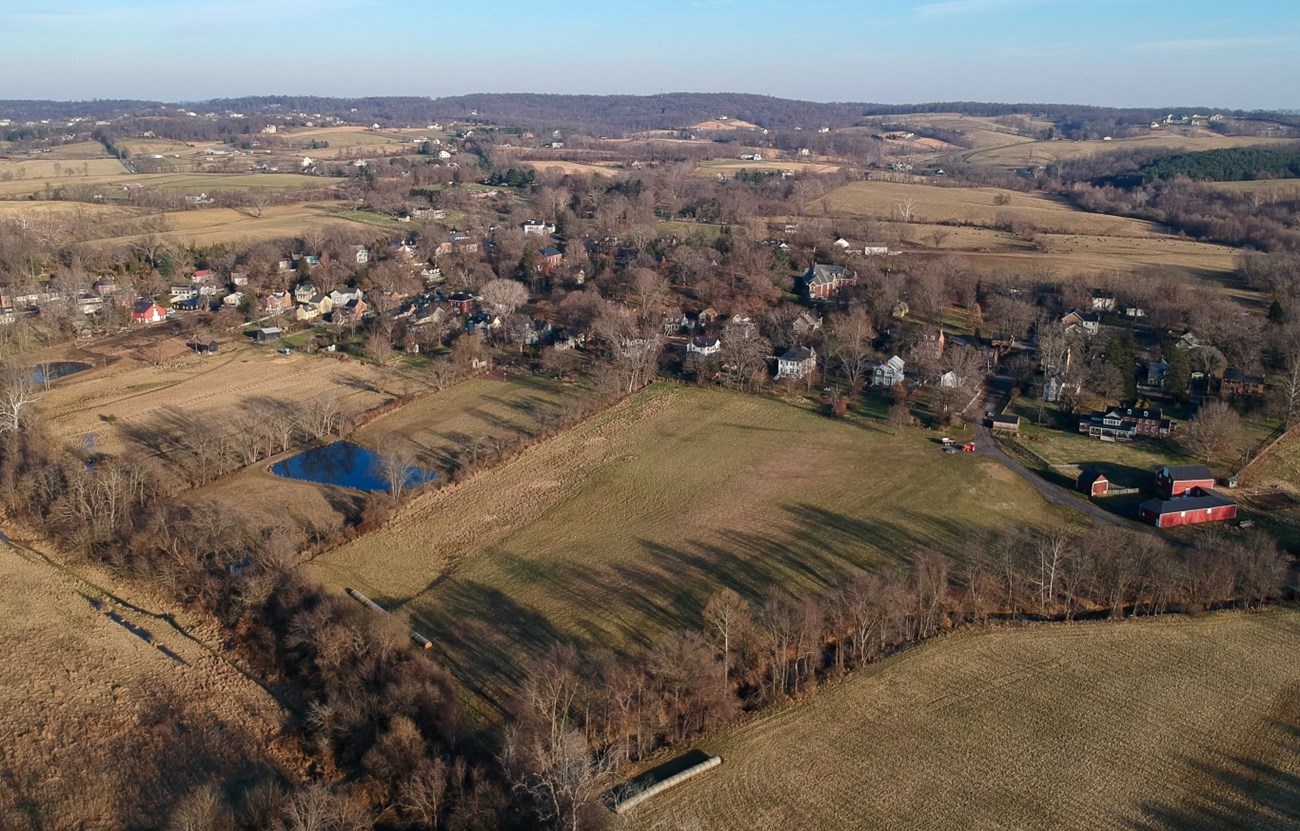
NPS Photo/University of Delaware, Center for Historic Architecture and Design staff, December 2019
Viewsheds and Boundaries
Another key theme of the interviews was the innovative nature of Waterford’s historic district, particularly the inclusion of its rural surroundings, which necessitated innovative strategies to protect the rural parcels along with the core village. Brown Morton, who created the district’s boundaries in 1969, was aware that his approach was quite “unusual for that time.”
Brown Morton: "I don’t remember there being any objections. I tried to explain to them why I didn’t want to go with property boundaries, but I wanted to go with a boundary that established the integrity of the viewshed. That’s what I was trying to achieve, and that, of course, doesn’t always coincide with property boundaries."
Morrisey: "And do you recall how you specifically mapped the lines, especially on the periphery where it kind of cut across various property lines?"
Brown Morton: "Yeah, I went and stood with my back to every single building in the village and looked out and I thought, what can I reasonably establish, an achievable boundary which doesn’t appear to be overreaching? But neither do I want to establish a boundary that is too close in. So, I wasn’t paying attention to legal boundaries. I was looking at the site because I felt that what makes Waterford nationally significant is the unspoiled preservation of not only the place but the viewshed."
-Conversation between W. Brown Morton III and Catherine Morrisey, 2021
Elizabeth Brabec, a professor of landscape architecture and the consultant that advised Waterford on land preservation in the 1990s, believes that “the inclusion of very large expansive boundaries in the 1970s was revolutionary” and “incredibly forward-thinking.”
“And so, in many ways, I think that the inclusion of very large expansive boundaries in the 1970s was revolutionary.”
-Elizabeth Brabec, 2021
Yet to protect that landscape setting required a sustained campaign that Brabec suggests was “the first in the country,” occurring during “a period when we were just beginning to talk about larger landscapes internationally and nationally.”
"Then you go to the protection of that landscape setting, which was the first at the time, the first in the country. It was at a period when we were just beginning to talk about larger landscapes internationally and nationally, that they were just beginning to be accepted as opportunities and possibilities for designation and preservation. And then the way that we went about developing its conservation management plan was significant, as well, that first use of a right of first refusal, the first use of a limited development plan and a cultural landscape context critical to engaging that landscape conservation strategy.”
-Elizabeth Brabec, 2021
Development Rights and a Limited Development Strategy
Professionals and academics had previously engaged in “a lot of discussion about cultural landscapes as designed landscapes,” especially small gardens and parks, but the efforts in Waterford represented “the cutting edge of this movement” to look at large, vernacular landscapes—and how to conserve open space without denying landowners of their property's economic value. In addition to the aggressive easement campaign, Brabec points to “two firsts” that were attempted in Waterford to preserve the open space in its National Historic Landmark district: a right of first refusal to purchase development rights, called "The Waterford Compact", and the application of a “limited development strategy,” which had never been employed in any cultural landscapes up to that point.“So, I think what you just said brings up two firsts for the Waterford project and Waterford landscape. One is this right of first refusal for development rights in the landscape of a national historic landmark, and the other one is the application of a limited development strategy, which had not been done in any cultural landscapes at this point.”
-Elizabeth Brabec, 2021
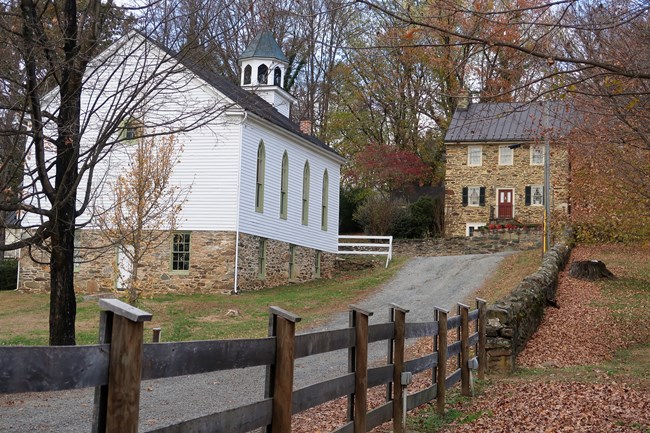
NPS Photo/University of Delaware, Center for Historic Architecture and Design staff, December 2019
Demographic Shifts
Several informants described how the preservation and gentrification of Waterford had racial implications and, more broadly, contributed to demographic shifts in the village. John Chamberlin, Brown Morton, and Margaret Morton all reported that Waterford village was more racially and economically diverse in the mid-twentieth century and that its social character and economic basis had changed tremendously over the past fifty years. They all recalled that a number of Black families lived in Waterford until the late-twentieth century.1During the early preservation campaign from the 1940s through the 1970s, demographic shifts were happening across Loudoun County and in Waterford itself. The preservation campaign in Waterford may have contributed to the gradual gentrification of the village during the mid-to-late twentieth century. Some of the demographic changes in Waterford are reflective of population shifts that happened within Loudoun County and in the nation more broadly during the mid- and late twentieth century. The overall population of the county grew, initially in large part due to an influx of resident commuters who worked in Washington, D.C. Expanded and improved roadways combined with the increased affordability of the automobile by the 1930s made this influx of commuters possible.2 Inversely, as the economy shifted increasingly away from agriculture, the younger and laboring members of rural villages and towns, like Waterford, increasingly moved to urban centers for employment opportunities. Some of those displaced were long-time African American families in Waterford. Rising property values and real estate costs also drove out long-time residents.3
About the project
The information gathered through this oral history project provided valuable insights for the amended Waterford National Historic Landmark nomination. In particular, the interviews helped further develop and enhance the argument that Waterford’s historic district is nationally significant for its sustained and innovative preservation efforts.
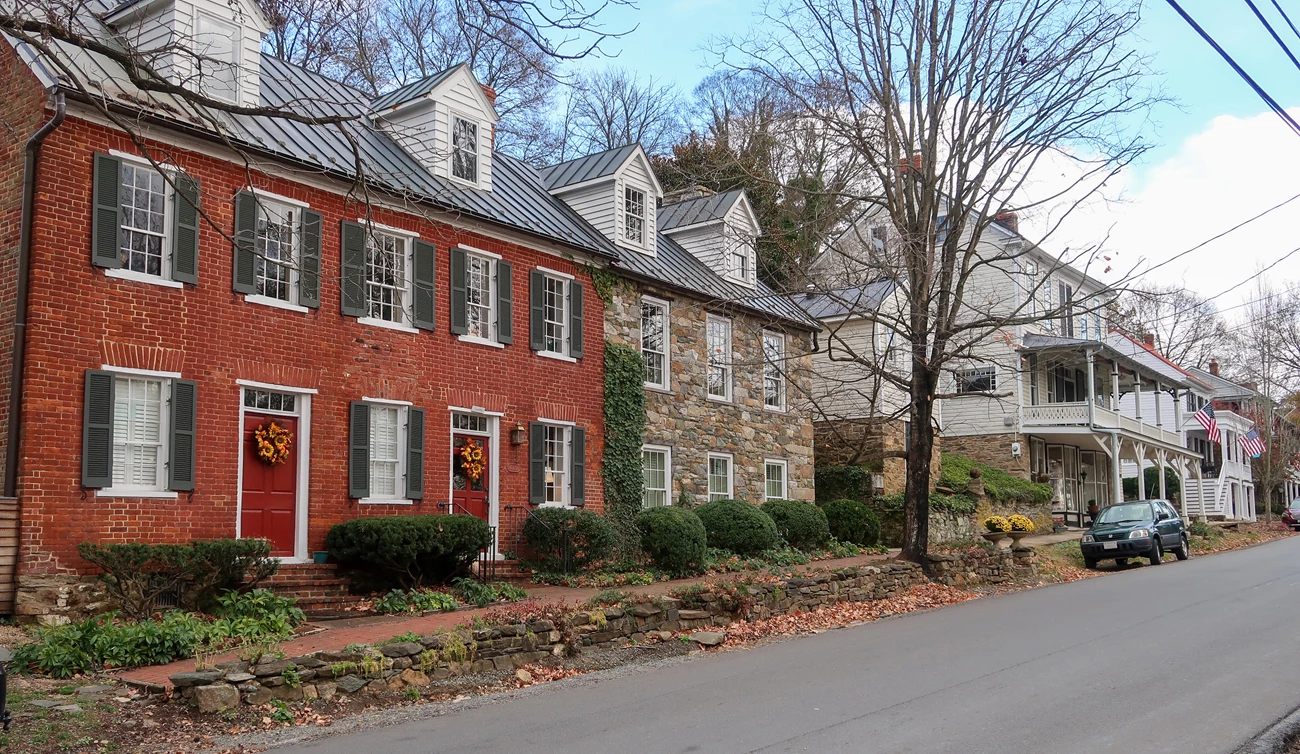
NPS Photo/University of Delaware, Center for Historic Architecture and Design staff, December 2019
Footnotes
1 No former African American residents of Waterford nor their descendants responded to interview requests for this project. Their perspectives would provide invaluable insight into these demographic changes and should be pursued in future studies.2 Kathryn Gettings Smith, Edna Johnston, and Megan Glynn, “Loudoun County African-American Historic Architectural Resources Survey,” Prepared by History Matters LLC for Loudoun County Planning Department, Washington, D.C, September 2004.
3 According to historical U.S. Census records, in 1860, an estimated 20% of Waterford’s residents were Black and 80% were White. The percentage of African American residents remained relatively constant through 1920 at least [Bronwen and John Souders, Waterford's African-American Experience & Timeline accessed 14 December 2022, Waterford's African-American Experience & Timeline | History of Waterford Virginia (waterfordhistory.org)]. Federal census records from 1950 show that 18% of Waterford’s residents were Black (56) and 82% were White (254). Most of the Black residents lived on Main Street between Bond and High streets (1950 Census, Loudoun County, ED#: 54-9). Data from 2018 reported on unitedstateszipcodes.org (derived from U.S. Census data and other sources) indicates that 2 percent of the residents in the zip code that includes Waterford (the zip code covers a larger geographic area than the Waterford NHL district) were Black and 91 percent were White. Note that after 1950, we do not have access to detailed census records indicating the ethnicity of those living within the NHL district.
Last updated: January 11, 2024
